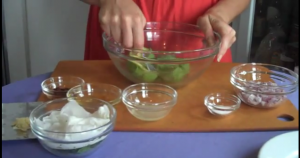Cook With All Your Senses

Put all your senses to work and rely on your sense of smell and touch to cook like a pro.
Sometimes, it’s the sensory tips that can help you master the basics of choosing and cooking foods.
Produce
- Smell, squeeze and taste. Some markets will let you sample fresh produce. Ask at your store.
- Pull the stem off an avocado. If the spot that becomes visible is green, the avocado is good. If it’s brown, it’s overripe.
- Pomegranates should be completely red and feel heavy for their size.
- Check fresh berries for mold; it’s the first sign that they are going bad.
- Perfectly ripe mangoes and melons should smell very fragrant.
- Eggplant should be free of blemishes and feel heavy for the size.
Meats and fish
- Fresh fish should smell like the ocean breeze. If it smells like the low tide, it’s past its prime. Ask to smell the fish before buying. If you’re buying a whole fish, the eyes should be clear and gills should be red and shiny.
- If you poke fresh meat, it should come back to form. If it retains the indentation from your finger, it isn’t worth purchasing.
Use quality ingredients
- Kosher salt is best for cooking because the granules dissolve quickly.
- Extra virgin olive oil comes from the first press of the olives, so it is the purest form. Later presses are often cut with other oils.
- For high-temperature sautéing or frying, canola, peanut, safflower and corn oil are best.
- Always cook with unsalted butter so you control the amount of salt that goes into your dish.
- High-quality Parmigiano-Reggiano cheese far surpasses that of the pre-packaged type, so pick some up for grating over pasta or soups.
- Look for the Muir Glen brand of canned tomato products.
- Good-quality chocolate can take a delicious dessert over the top.
Are you throwing a bridal shower or dinner party this summer? Put your senses to the test and tempt your guests by trying one or all of these recipes.
Chucky Guacamole (video)
Salt-Roasted Prawns with Basil Pesto
Lemon Granita
Mini Pita Pockets with Tzatziki Sauce
Kenmore
The Kenmore brand represents 100 years of trusted performance, backed by exclusive features and innovations that no other brand can bring to the table. We’re always evolving to ensure day-to-day tasks are taken care of with faster cooking, better cleaning and more living throughout the home.




